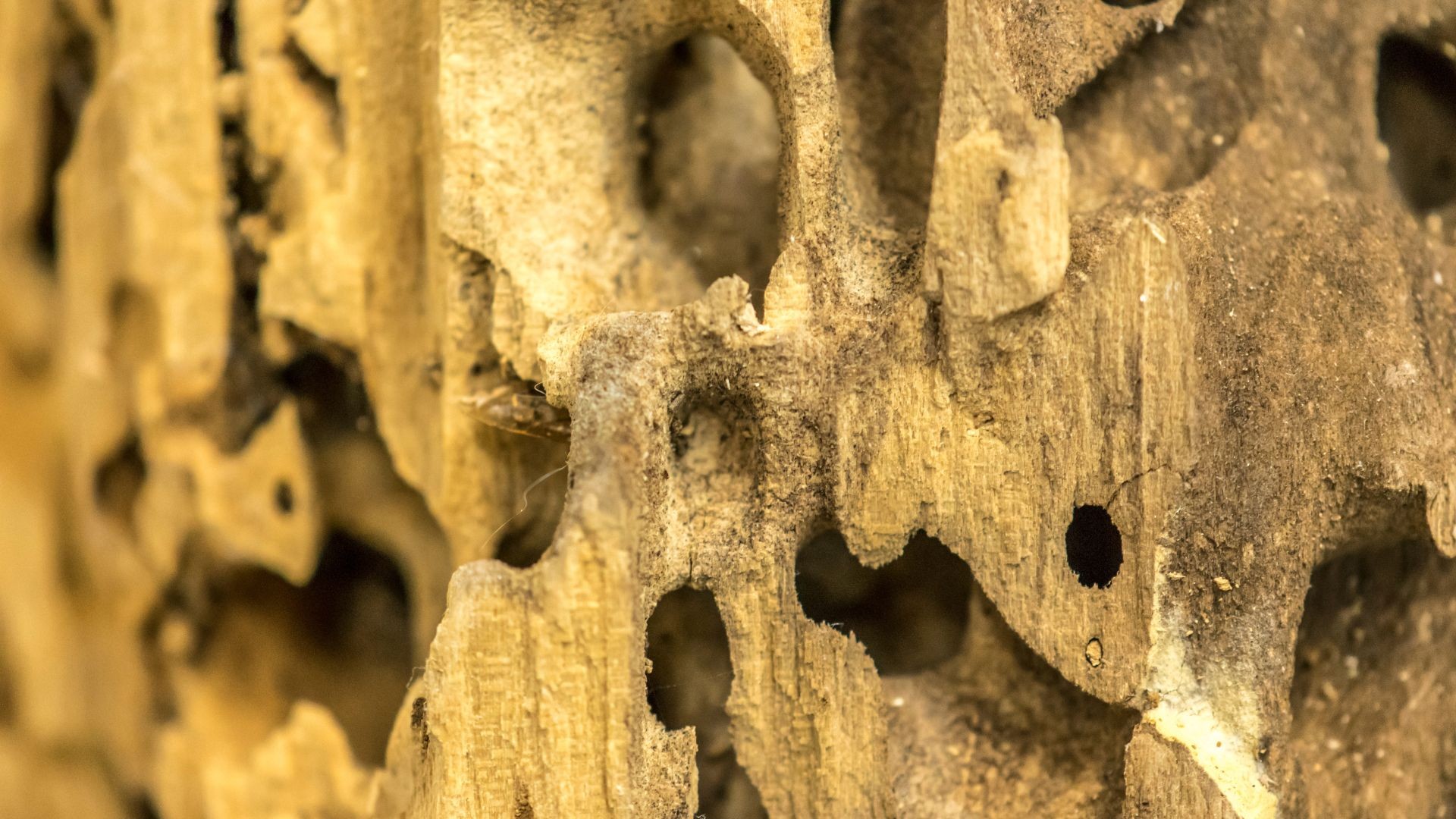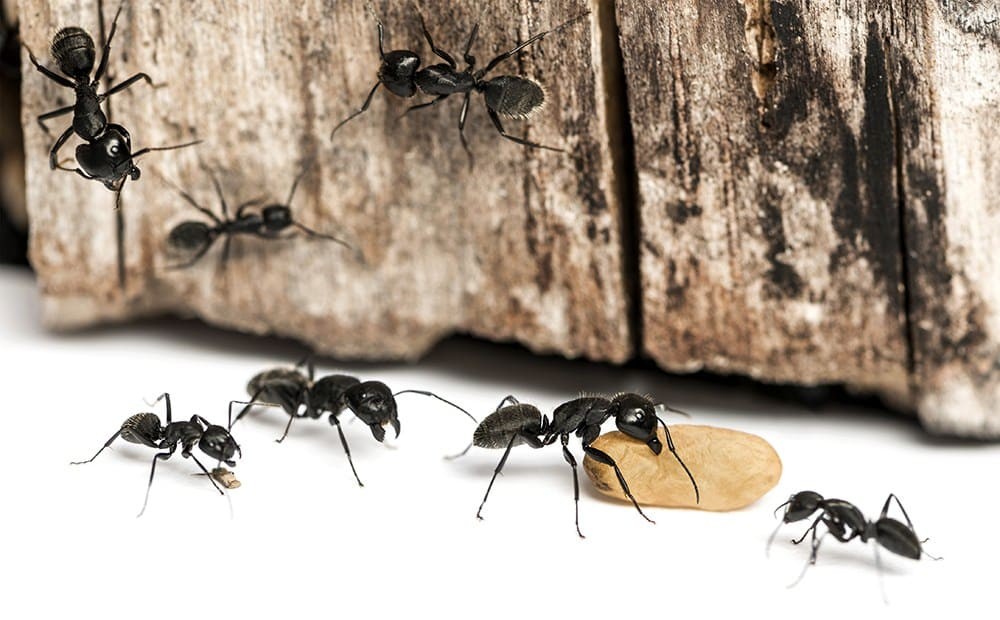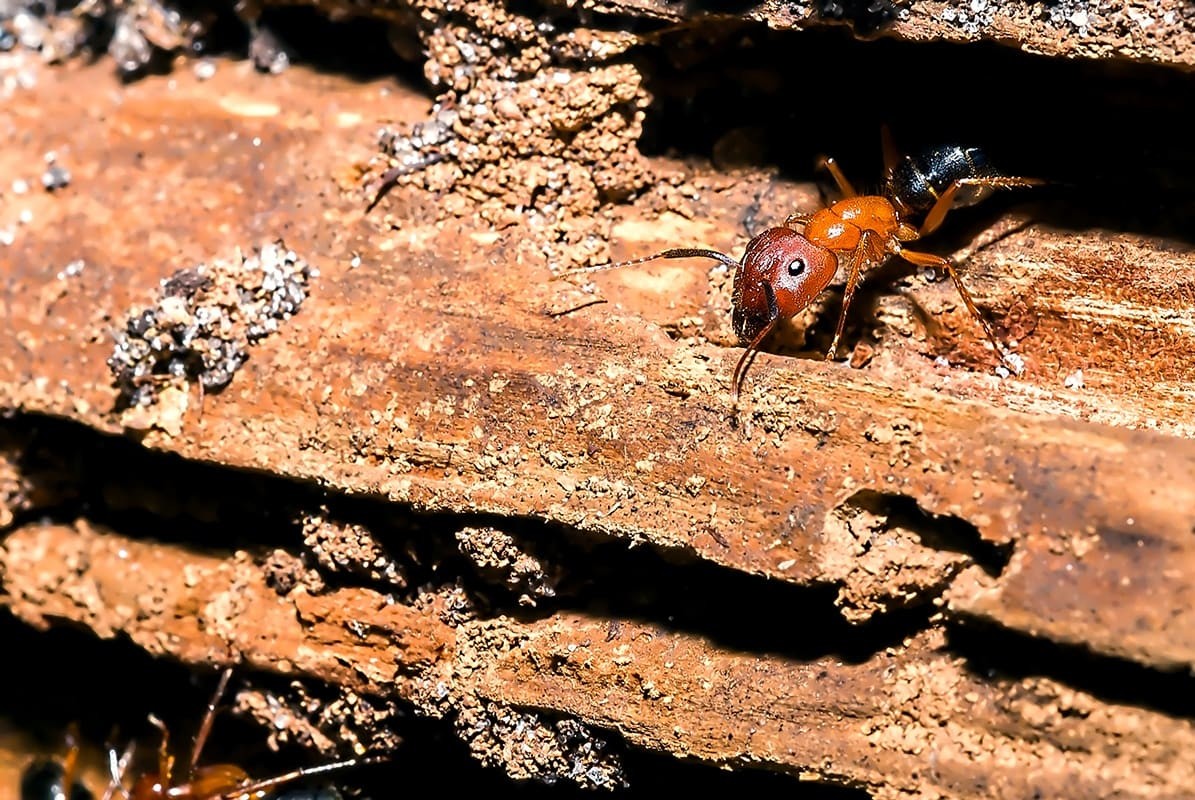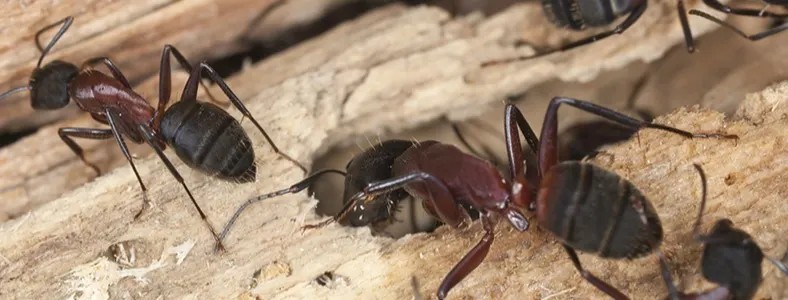Carpenter ants can cause significant property damage, so it’s crucial to address an infestation promptly. At HOW.EDU.VN, we provide expert guidance on effective carpenter ant control and prevention, ensuring your home remains safe and sound. Discover proven methods and expert insights to eliminate these destructive pests and safeguard your property from further harm.
1. Understanding Carpenter Ants
What Are Carpenter Ants?
Carpenter ants are a type of ant that excavates wood to build nests, unlike termites that consume wood. These ants create smooth, distinctive nests in moist, decaying wood both outdoors and indoors. According to a study by the University of California, Davis, carpenter ants are among the most common structural pests in the United States. Their nesting sites can be found in doors, window sills, tree branches, and wall voids, wherever there is a natural cavity or hollow.
How to Identify Carpenter Ants
Carpenter ants don’t eat wood, but they cause damage by hollowing it out for nesting. Look for frass, a fine sawdust-like material, which indicates their nesting activity.
| Feature | Carpenter Ants | Termites |
|---|---|---|
| Body Segments | Three | Two |
| Antennae | Bent | Straight |
| Color | Black or dark brown | Light |
| Damage | Clean, smooth tunnels in wood | Mud tubes, damaged wood with soil inside |
| Droppings (Frass) | Sawdust-like, expelled outside the nest | Hard, pellet-shaped droppings inside tunnels |






2. Identifying a Carpenter Ant Infestation
Step 1: Distinguish Between Carpenter Ants and Termites
First, confirm whether you’re dealing with carpenter ants or termites. Carpenter ants are large, black or dark brown insects with three body segments, six legs, and bent antennae. Reproductive carpenter ants have wings, while worker ants do not. Termites, on the other hand, have straight antennae and light-colored bodies.
Step 2: Inspect for Frass
Look for frass, which resembles sawdust. This material is produced when carpenter ants drill into wood to create their nests. Frass will appear as a mound of light wood shavings, often containing pieces of dead insects and other waste.
Step 3: Examine Wood for Damage
Carpenter ants chew cuts or holes into wood to make nests. There’s usually frass spread around the damaged area. They often nest inside hollow doors, walls, cabinets, beams, and other structural wood. They prefer damp wood, so check for moisture in these areas. You might also find carpenter ants infesting rotting trees outside your home.
Step 4: Place Bait to Locate the Nest
To find the nest, lure the ants with bait and follow them back to their colony. Place small pieces of honeydew melon or other sugary fruits near suspected nesting sites.
Step 5: Track the Ants to Their Nest
Once the ants take the bait, follow them to their colony. You’ll likely see them squeezing through cracks in walls, floors, or doorways. If the nest is visible and accessible, eliminate it directly. If it’s hard to find, use poisonous bait. The effect may take about three days.
3. Effective Methods to Get Rid of Carpenter Ants
3.1. Use Toxic Bait for Rapid Elimination
If the carpenter ant colony is hidden, toxic bait is highly effective. Purchase poisonous gel bait for carpenter ants from a local hardware store and mix it with a teaspoon of sugar and milk. According to a study published in the Journal of Economic Entomology, slow-acting baits are more effective because they allow worker ants to carry the poison back to the colony, eliminating the entire population.
How to Apply Toxic Bait:
- Combine poisonous gel bait with sugar and milk.
- Apply the bait to entice ants out of their nest.
- Allow the ants to carry the bait back into the nest.
Important Note:
Avoid spraying insecticide on carpenter ants, as this can cause them to scatter and build more nests. Use tamper-proof bait stations if you have pets or young children to ensure safe administration of poisonous baits.
3.2. Direct Dusting of Nests
This method works best when you can easily access the nest. Purchase carpenter ant dust and apply it directly to the nest as instructed on the packaging.
Recommended Product:
D-Fense Insecticide Dust is a fast-acting chemical dust. However, it contains toxic chemicals, so apply it safely and correctly with a duster.
How to Treat Nests with Direct Dusting:
- Purchase carpenter ant dust.
- Apply the dust directly to the nest.
- Ensure the queen and entire colony are exposed.
3.3. Boric Acid Treatment
Boric acid is a potent chemical for eliminating carpenter ant infestations. Mix powdered sugar and boric acid in a 1:2 ratio. Pour the mixture into bottle caps and place them where you see carpenter ants.
How Boric Acid Works:
Worker ants carry the boric acid back to the nest, killing the colony. Boric acid penetrates the ant’s body and dissolves internally.
Steps for Using Boric Acid:
- Mix powdered sugar and boric acid (1:2 ratio).
- Pour the mixture into bottle caps.
- Place the bottle caps in areas frequented by ants.
3.4. Disrupting Scent Trails
Carpenter ants rely on pheromone trails to move and find food. Disrupt these trails by cleaning surfaces where ants have walked.
Methods to Disrupt Scent Trails:
- Wipe surfaces with a cotton ball dipped in essential oils (tea tree, cedarwood, or citrus).
- Prepare a solution of one part liquid dish soap and two parts water, or equal parts water and white vinegar, and spray it on the trails or inside the nest.
3.5. Applying Diatomaceous Earth
Diatomaceous Earth is a natural substance that dehydrates carpenter ants and other insects by breaking down their exoskeletons.
How to Apply Diatomaceous Earth:
- Drill one-inch holes every six inches in affected areas.
- Blow the diatomaceous earth into the holes.
Safety Note:
Handle diatomaceous earth carefully to avoid inhaling the dust, which can damage your lungs. While it is generally safe for pets and children, exercise caution.
3.6. Pest Control Subscriptions for Year-Round Protection
Consider pest control subscription options like Riddy, which offers a tailored approach to whole-home pest control, providing peace of mind from carpenter ants and other pests.
4. Best Baits for Carpenter Ants
4.1. Maxforce Fleet Ant Bait
Maxforce Fleet is a Fipronil-based gel with high moisture content that eliminates ants in three to five days. It’s particularly effective because carpenter ants ingest the sugar-based gel, store it, and then regurgitate it to feed other ants in the colony. Apply small doses of Maxforce Fleet using a bait injector or syringe applicator wherever you see ants running.
4.2. Advance 375A Ant Bait Gel
Advance 375A Ant Bait provides carpenter ants with the protein-based food they need. Use this bait if the ants are feeding on sugar or carbohydrates in your home.
4.3. Carpenter Ant Bait Combo
The Carpenter Ant Bait Combo Pack combines Advance 275A and Maxforce Fleet, maximizing savings while providing a comprehensive baiting solution.
5. Preventative Measures to Keep Carpenter Ants Away
5.1. Eliminate Clutter
Remove clutter to prevent carpenter ants from using it as nesting sites. Clean floors, fix leaks, and clear away any clutter that could provide them with a place to hide.
5.2. Seal Your Home
Prevent ants from entering your home by using caulk to seal cracks in the foundation and around entry points. Install screens on doors and windows. According to the Environmental Protection Agency (EPA), sealing entry points is a critical step in preventing pest infestations.
5.3. Clean Up Natural Debris
Trim tree limbs that hang directly over your home. Remove weeds, old wood piles, and natural debris, as they may house ant colonies.
5.4. Maintain Cleanliness
Ants need sugar, protein, and water to survive. Deny them these resources by:
- Sweeping up food crumbs.
- Cleaning spills, especially sugary substances.
- Fixing any leaks to eliminate water sources.
6. Addressing Common Concerns
How Serious Is a Carpenter Ant Infestation?
A carpenter ant infestation can be quite serious, as these pests can compromise the structural integrity of your home over time. Regular inspections and prompt treatment are essential to prevent extensive damage.
What Attracts Carpenter Ants to Homes?
Carpenter ants are attracted to moisture, decaying wood, and food sources. Addressing these factors is crucial in preventing infestations.
Can Carpenter Ants Bite?
Yes, carpenter ants can bite, although they typically do so only when disturbed. Their bites can be painful but are not medically significant.
Are DIY Methods Effective Against Carpenter Ants?
DIY methods can be effective for minor infestations, but severe infestations may require professional pest control services to ensure complete eradication.
7. Expert Consultation at HOW.EDU.VN
At HOW.EDU.VN, we understand the challenges of dealing with carpenter ant infestations. Our team of over 100 renowned PhDs and experts is dedicated to providing you with personalized advice and solutions.
Benefits of Consulting with Our Experts:
- Expert Knowledge: Gain insights from top professionals in pest control.
- Personalized Advice: Receive tailored solutions for your specific situation.
- Reliable Information: Access credible and up-to-date information.
- Convenient Access: Connect with experts from anywhere in the world.
Our experts stay updated with the latest research and techniques to offer the most effective strategies for carpenter ant control. Whether you’re dealing with a minor issue or a severe infestation, we can guide you through the process and ensure a successful outcome.
8. Contact Us for Expert Assistance
Don’t let carpenter ants compromise your home. Contact HOW.EDU.VN today for expert consultation and effective solutions.
Contact Information:
- Address: 456 Expertise Plaza, Consult City, CA 90210, United States
- WhatsApp: +1 (310) 555-1212
- Website: HOW.EDU.VN
Our team is ready to provide the support and expertise you need to protect your property from carpenter ants.
FAQ: Your Questions About Carpenter Ants Answered
1. What are the first signs of a carpenter ant infestation?
The first signs often include seeing large, black ants in your home, especially near wooden structures, and finding piles of sawdust-like material (frass).
2. How do I distinguish between carpenter ants and termites?
Carpenter ants have bent antennae, three body segments, and create clean, smooth tunnels in wood. Termites have straight antennae, two body segments, and create mud tubes and damage wood with soil inside.
3. What attracts carpenter ants to my home?
Carpenter ants are attracted to moisture, decaying wood, and available food sources like crumbs and spills.
4. Can I get rid of carpenter ants on my own, or do I need a professional?
For minor infestations, DIY methods like baits and boric acid can be effective. However, severe infestations often require professional pest control services.
5. What are the best DIY methods for carpenter ant control?
Effective DIY methods include using toxic baits, applying boric acid, disrupting scent trails, and applying diatomaceous earth.
6. How can I prevent carpenter ants from coming back after treatment?
Preventive measures include removing clutter, sealing your home, cleaning up natural debris, and maintaining cleanliness to eliminate food and water sources.
7. Are carpenter ant bites dangerous?
Carpenter ant bites can be painful but are generally not medically significant.
8. How do I find the carpenter ant nest?
Look for frass, follow ants carrying bait, and inspect damp or decaying wood.
9. What should I do if I find a carpenter ant nest in a tree?
Treat the nest with carpenter ant dust or call a professional pest control service for assistance.
10. How can HOW.EDU.VN help me with my carpenter ant problem?
HOW.EDU.VN connects you with over 100 renowned PhDs and experts who can provide personalized advice and effective solutions for carpenter ant control, ensuring your home remains protected.
By understanding carpenter ants, identifying infestations early, implementing effective control methods, and taking preventive measures, you can protect your home from these destructive pests. For expert guidance and personalized solutions, trust how.edu.vn to connect you with the best professionals in the field.